Презентация Writing and Defending a Course Paper 1 1

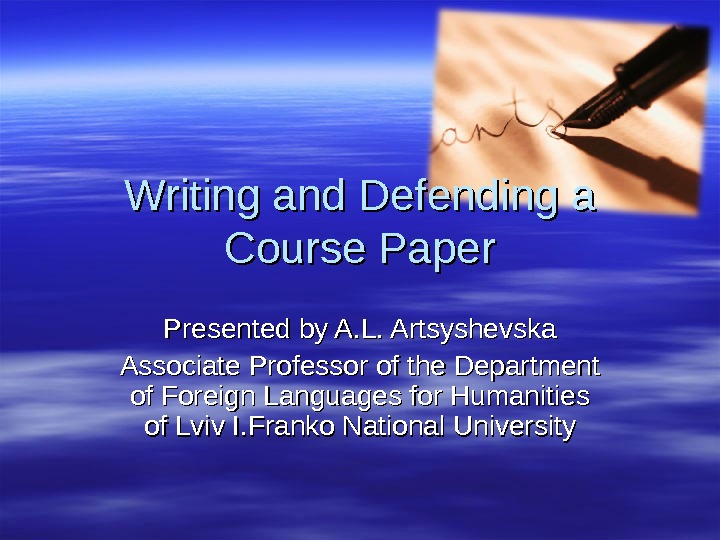
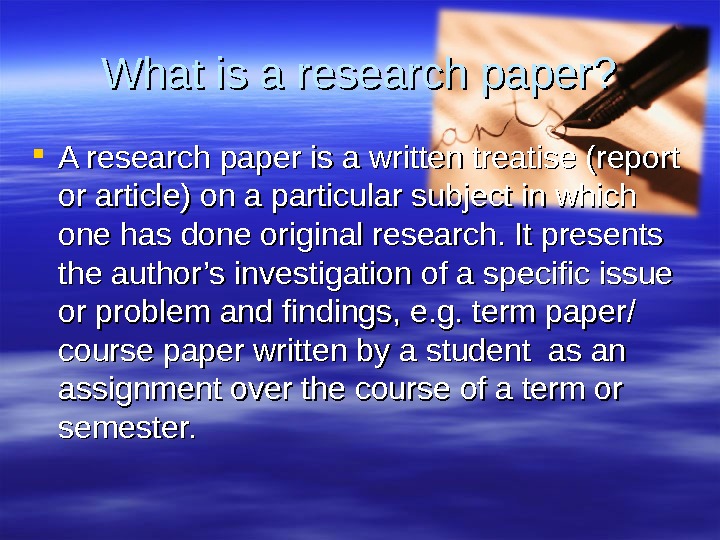
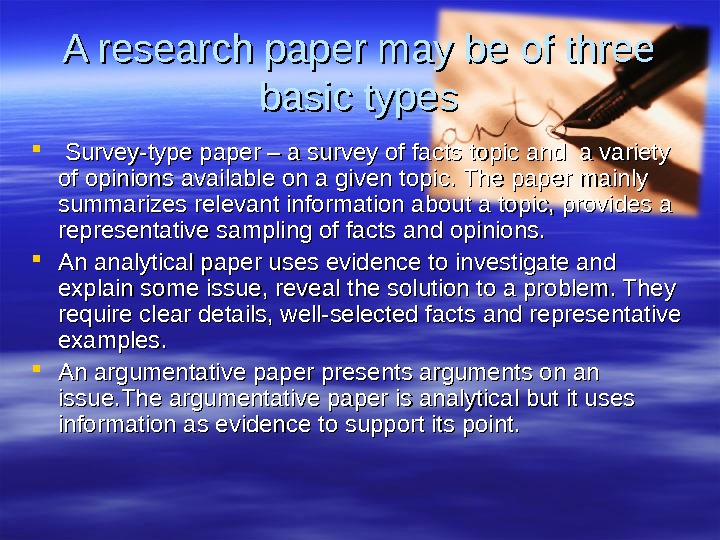
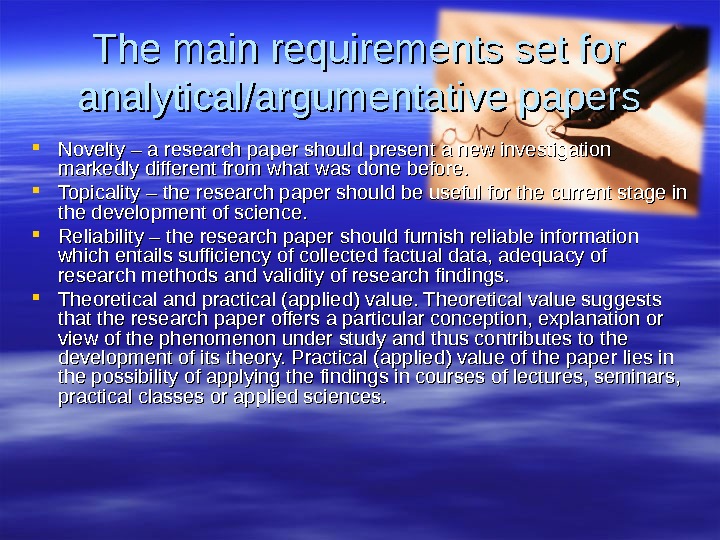
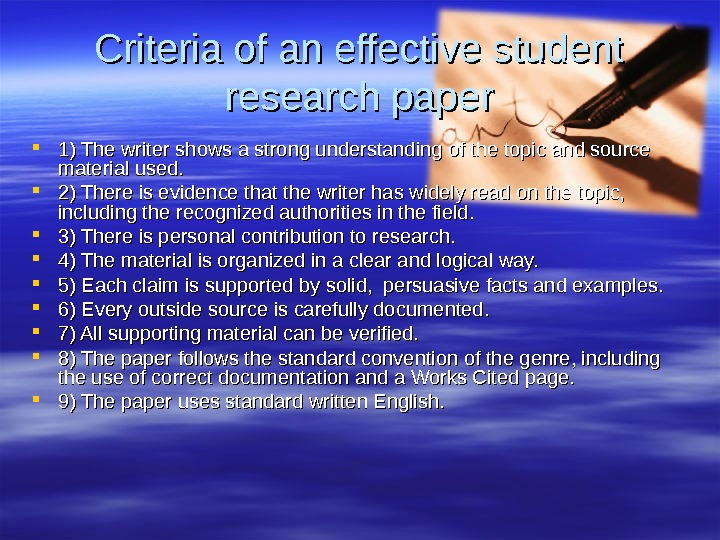
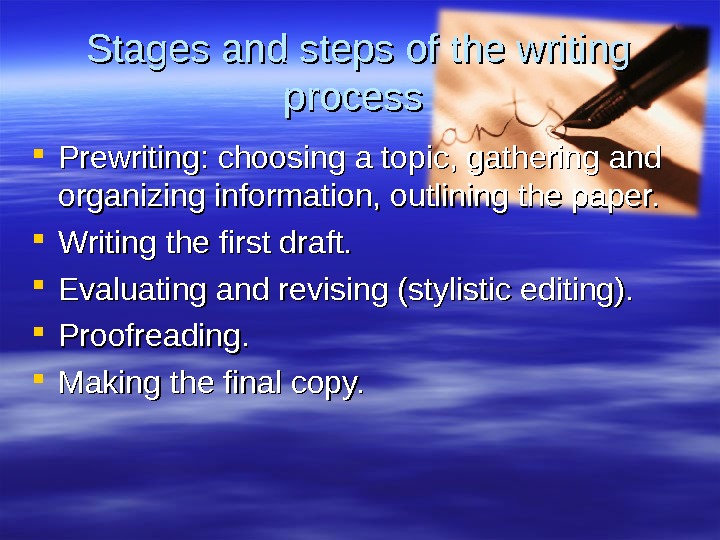
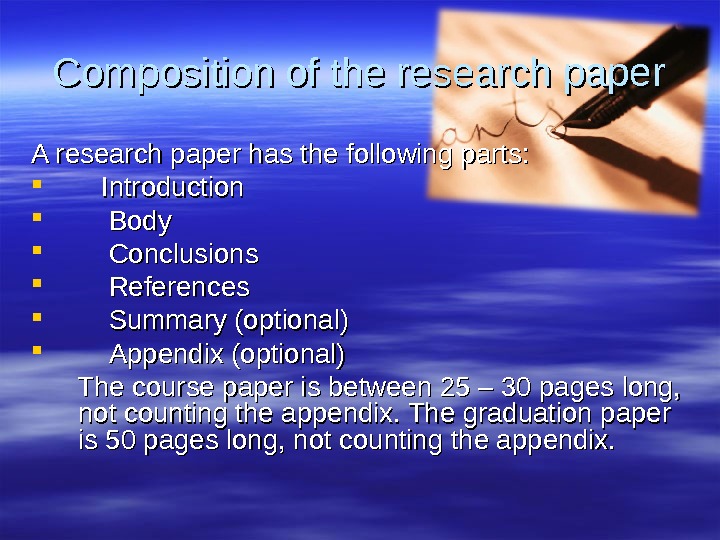
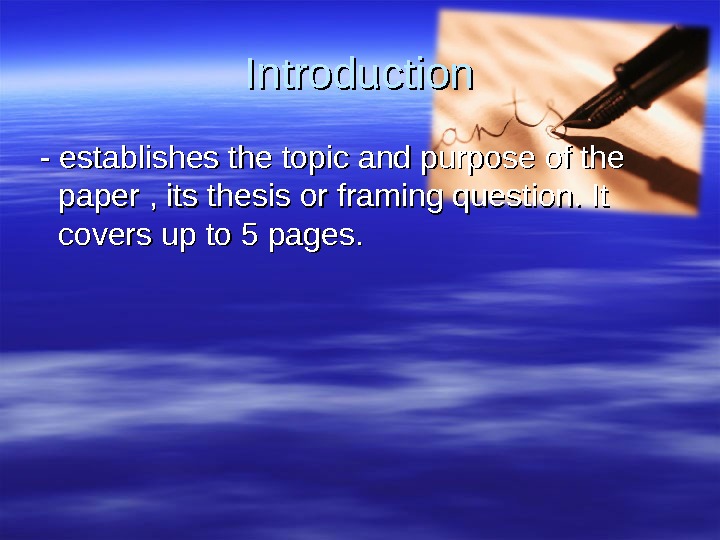
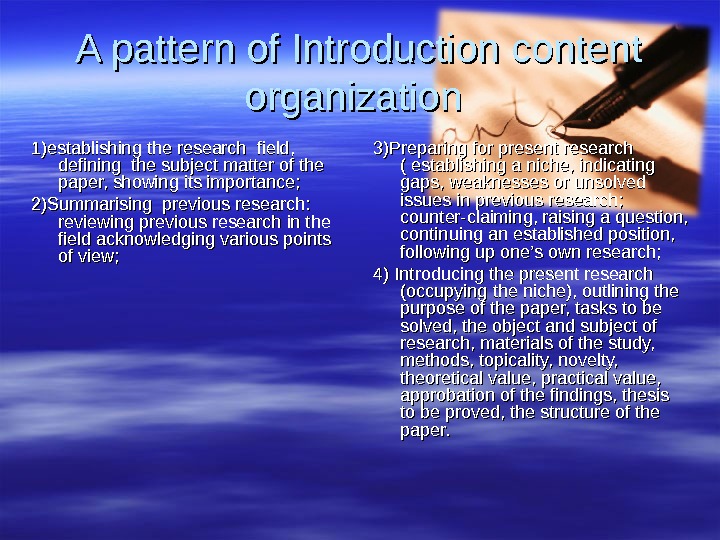
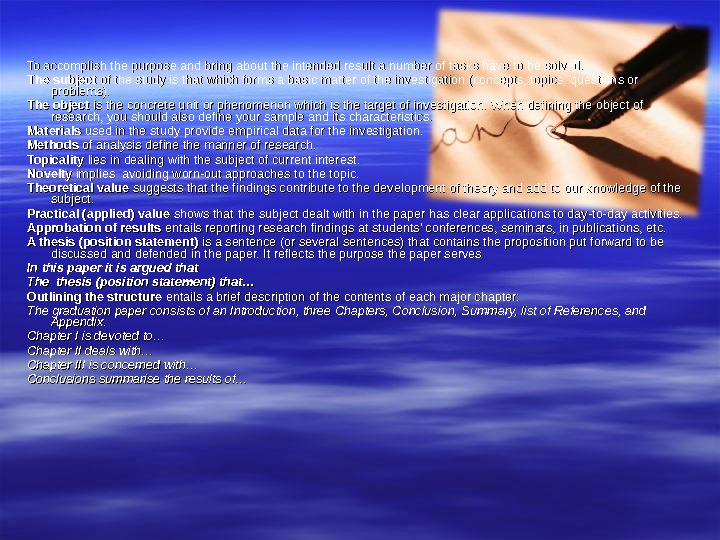
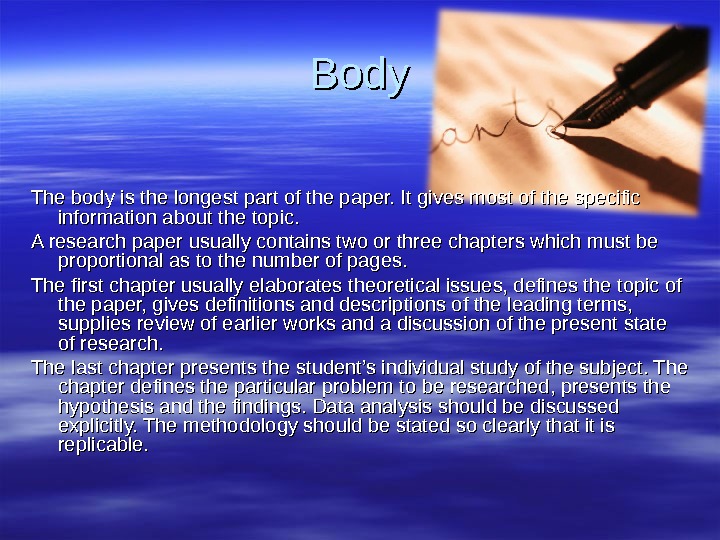
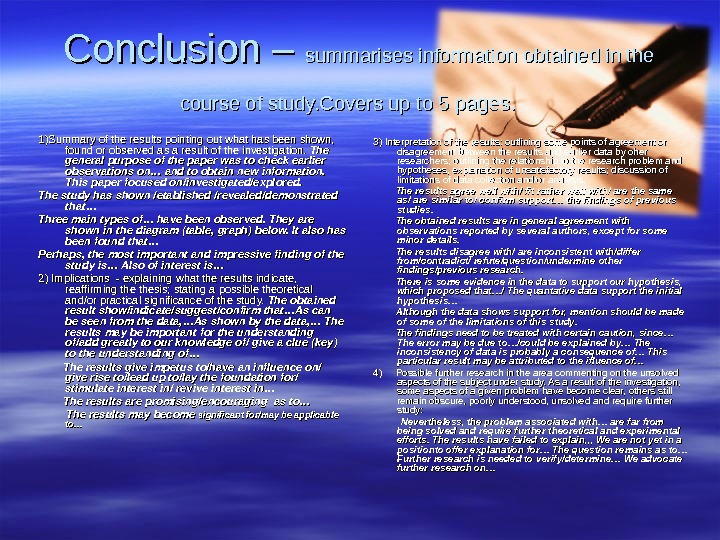
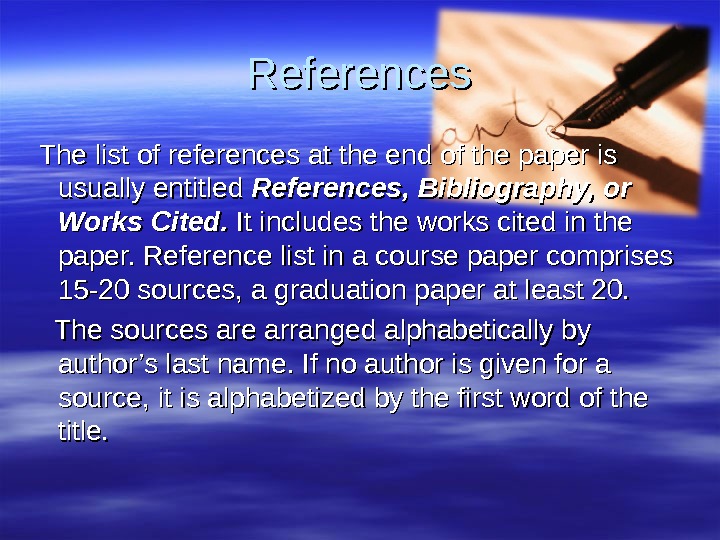
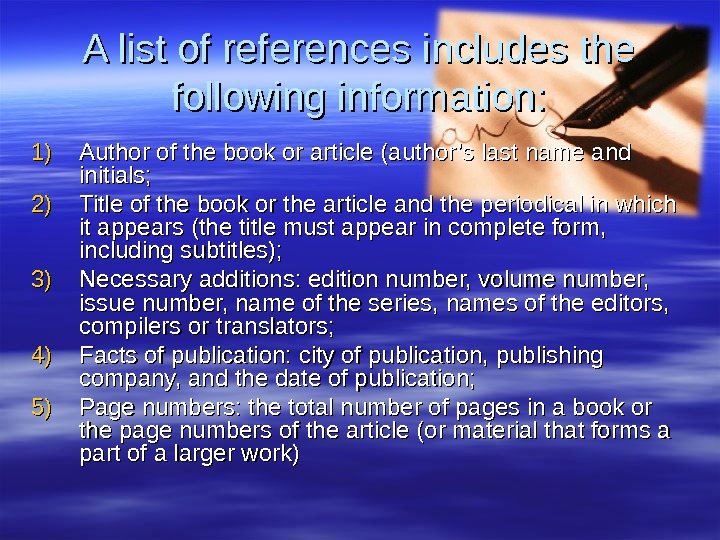
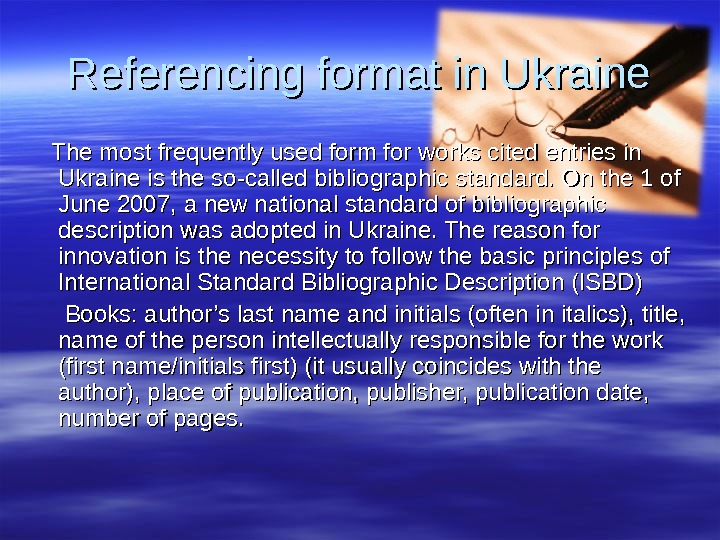
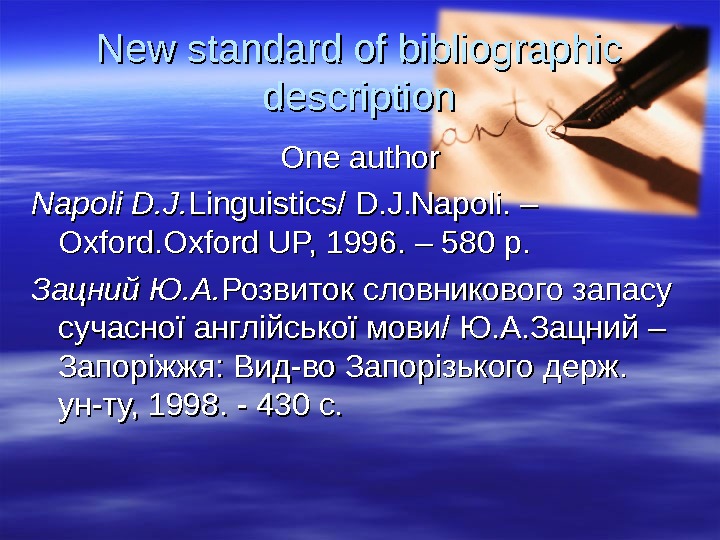
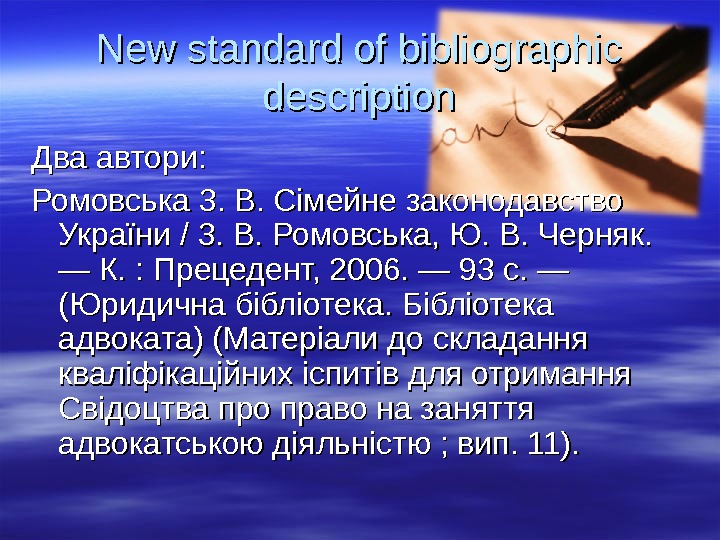
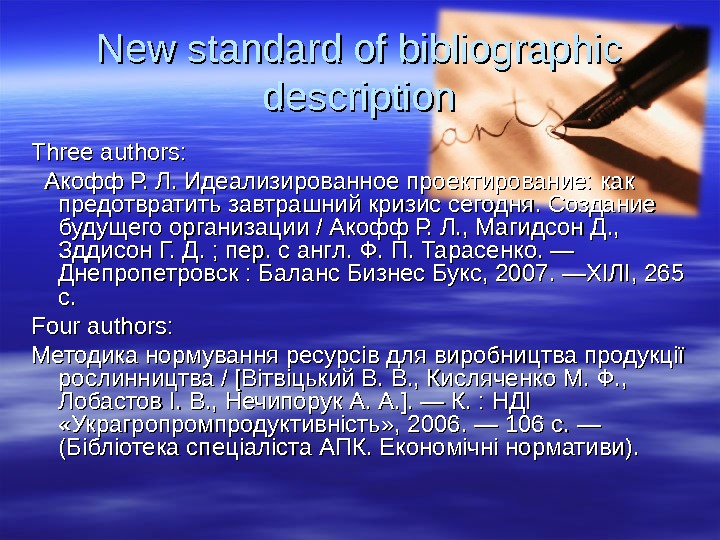
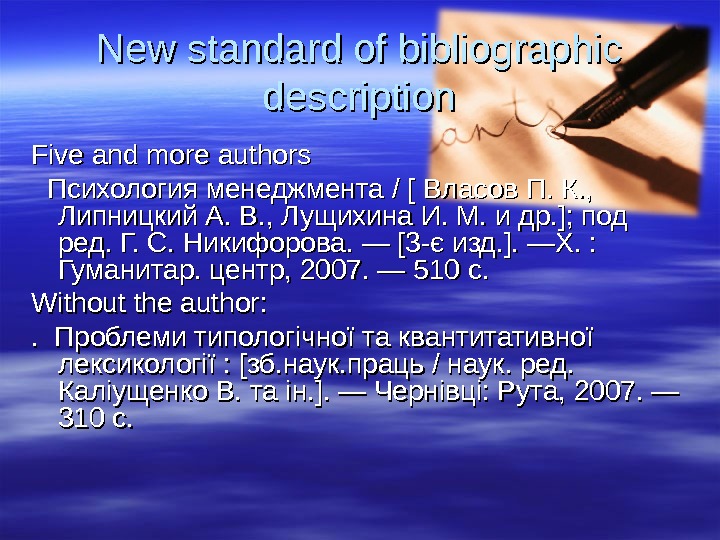
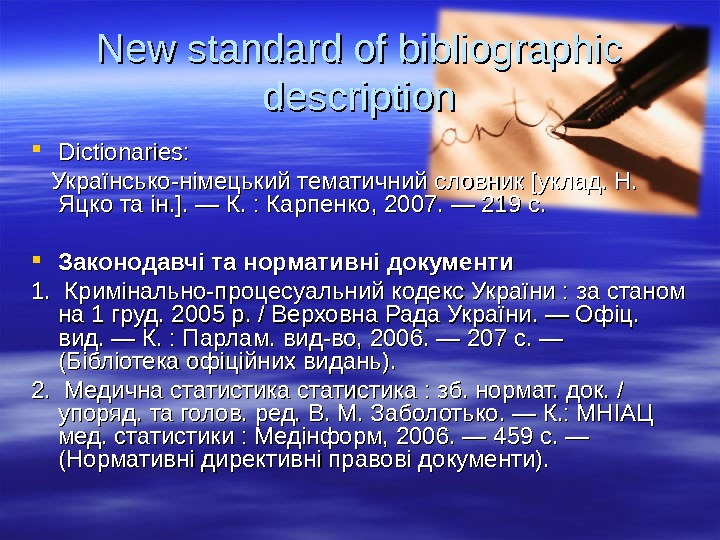
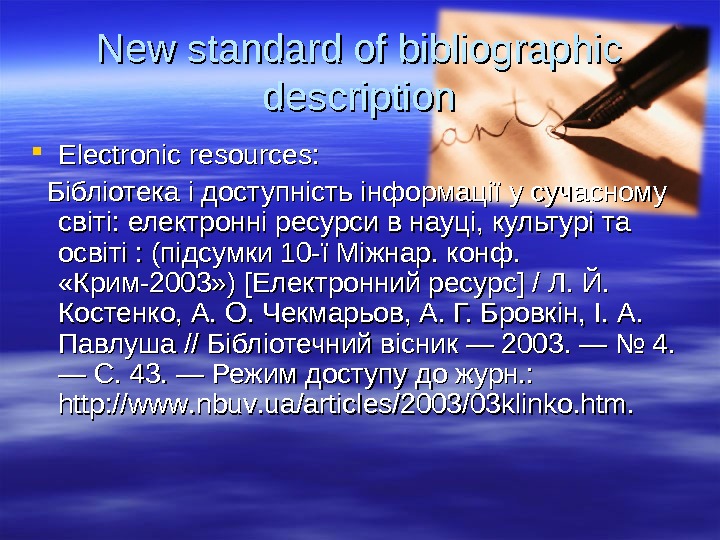
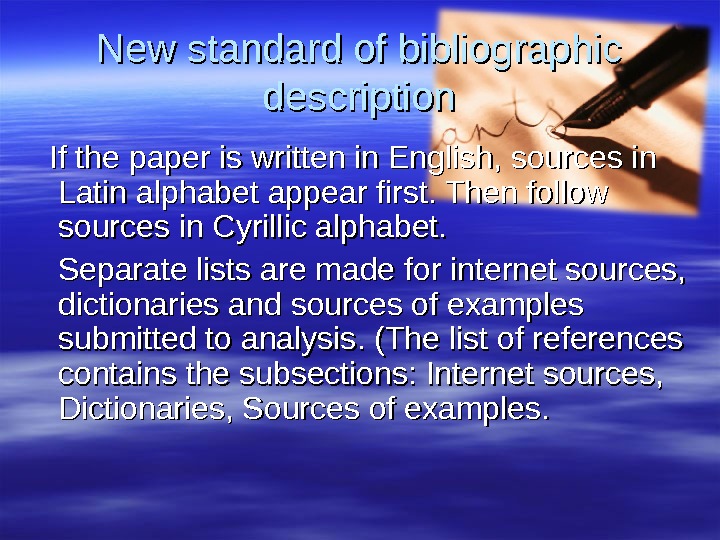
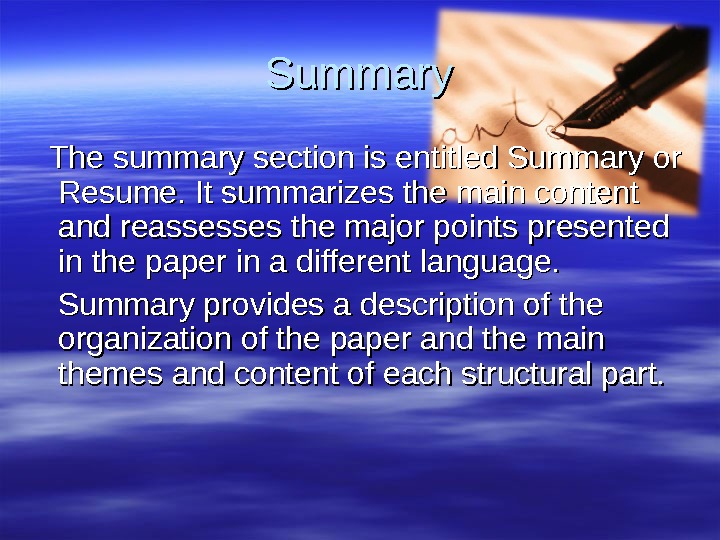
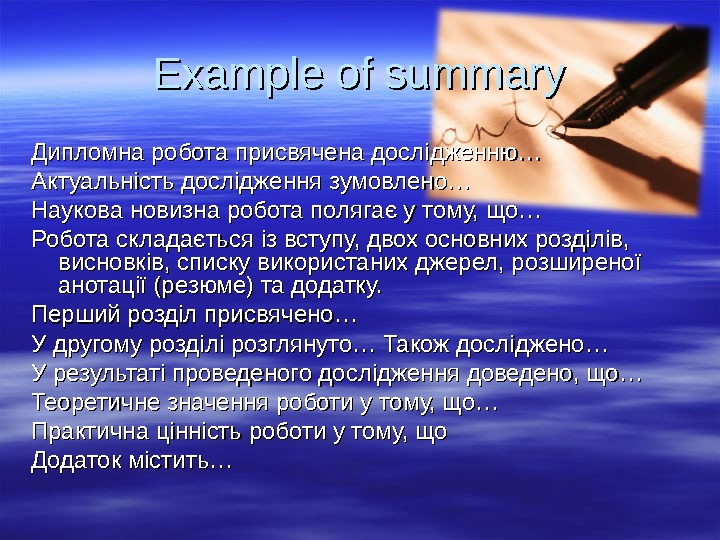
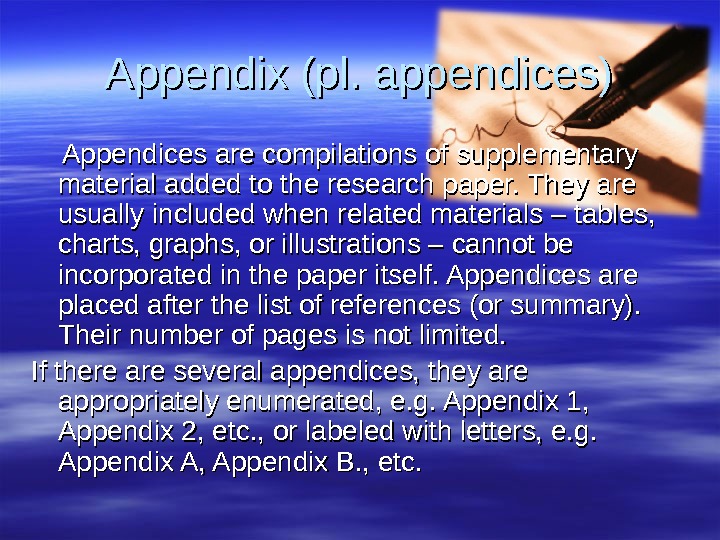
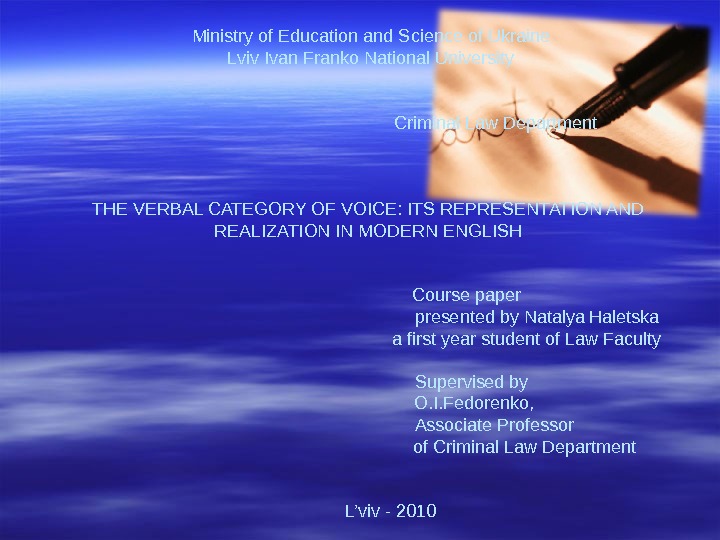
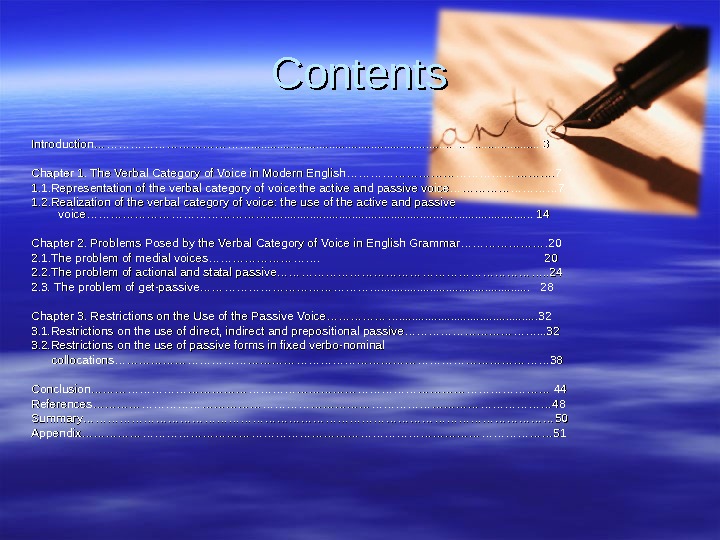
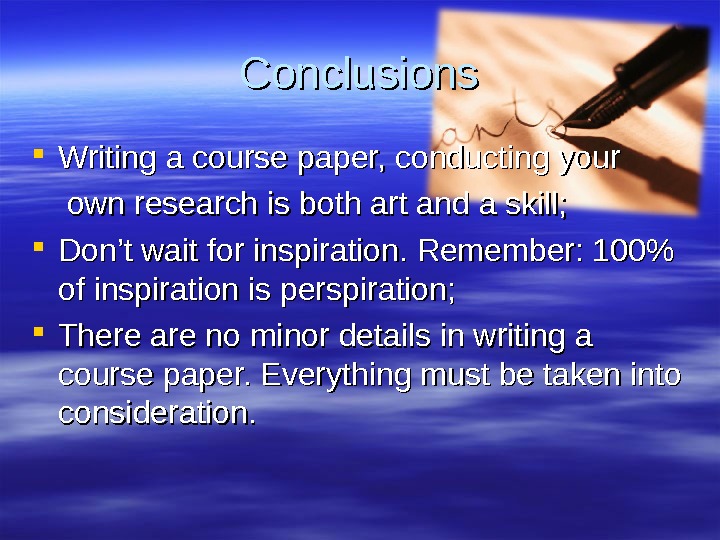
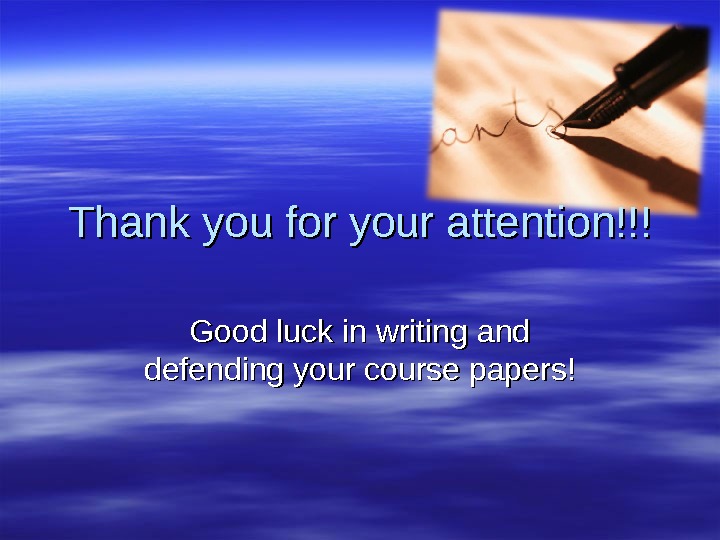
writing_and_defending_a_course_paper_1_1.ppt
- Размер: 1.6 Mегабайта
- Количество слайдов: 29
Описание презентации Презентация Writing and Defending a Course Paper 1 1 по слайдам
 Writing and Defending a Course Paper Presented by A. L. Artsyshevska Associate Professor of the Department of Foreign Languages for Humanities of Lviv I. Franko National University
Writing and Defending a Course Paper Presented by A. L. Artsyshevska Associate Professor of the Department of Foreign Languages for Humanities of Lviv I. Franko National University
 What is a research paper? A research paper is a written treatise (report or article) on a particular subject in which one has done original research. It presents the author’s investigation of a specific issue or problem and findings, e. g. term paper/ course paper written by a student as an assignment over the course of a term or semester.
What is a research paper? A research paper is a written treatise (report or article) on a particular subject in which one has done original research. It presents the author’s investigation of a specific issue or problem and findings, e. g. term paper/ course paper written by a student as an assignment over the course of a term or semester.
 A research paper may be of three basic types Survey-type paper – a survey of facts topic and a variety of opinions available on a given topic. The paper mainly summarizes relevant information about a topic, provides a representative sampling of facts and opinions. An analytical paper uses evidence to investigate and explain some issue, reveal the solution to a problem. They require clear details, well-selected facts and representative examples. An argumentative paper presents arguments on an issue. The argumentative paper is analytical but it uses information as evidence to support its point.
A research paper may be of three basic types Survey-type paper – a survey of facts topic and a variety of opinions available on a given topic. The paper mainly summarizes relevant information about a topic, provides a representative sampling of facts and opinions. An analytical paper uses evidence to investigate and explain some issue, reveal the solution to a problem. They require clear details, well-selected facts and representative examples. An argumentative paper presents arguments on an issue. The argumentative paper is analytical but it uses information as evidence to support its point.
 The main requirements set for analytical/argumentative papers Novelty – a research paper should present a new investigation markedly different from what was done before. Topicality – the research paper should be useful for the current stage in the development of science. Reliability – the research paper should furnish reliable information which entails sufficiency of collected factual data, adequacy of research methods and validity of research findings. Theoretical and practical (applied) value. Theoretical value suggests that the research paper offers a particular conception, explanation or view of the phenomenon under study and thus contributes to the development of its theory. Practical (applied) value of the paper lies in the possibility of applying the findings in courses of lectures, seminars, practical classes or applied sciences.
The main requirements set for analytical/argumentative papers Novelty – a research paper should present a new investigation markedly different from what was done before. Topicality – the research paper should be useful for the current stage in the development of science. Reliability – the research paper should furnish reliable information which entails sufficiency of collected factual data, adequacy of research methods and validity of research findings. Theoretical and practical (applied) value. Theoretical value suggests that the research paper offers a particular conception, explanation or view of the phenomenon under study and thus contributes to the development of its theory. Practical (applied) value of the paper lies in the possibility of applying the findings in courses of lectures, seminars, practical classes or applied sciences.
 Criteria of an effective student research paper 1) The writer shows a strong understanding of the topic and source material used. 2) There is evidence that the writer has widely read on the topic, including the recognized authorities in the field. 3) There is personal contribution to research. 4) The material is organized in a clear and logical way. 5) Each claim is supported by solid, persuasive facts and examples. 6) Every outside source is carefully documented. 7) All supporting material can be verified. 8) The paper follows the standard convention of the genre, including the use of correct documentation and a Works Cited page. 9) The paper uses standard written English.
Criteria of an effective student research paper 1) The writer shows a strong understanding of the topic and source material used. 2) There is evidence that the writer has widely read on the topic, including the recognized authorities in the field. 3) There is personal contribution to research. 4) The material is organized in a clear and logical way. 5) Each claim is supported by solid, persuasive facts and examples. 6) Every outside source is carefully documented. 7) All supporting material can be verified. 8) The paper follows the standard convention of the genre, including the use of correct documentation and a Works Cited page. 9) The paper uses standard written English.
 Stages and steps of the writing process Prewriting: choosing a topic, gathering and organizing information, outlining the paper. Writing the first draft. Evaluating and revising (stylistic editing). Proofreading. Making the final copy.
Stages and steps of the writing process Prewriting: choosing a topic, gathering and organizing information, outlining the paper. Writing the first draft. Evaluating and revising (stylistic editing). Proofreading. Making the final copy.
 Composition of the research paper A research paper has the following parts: Introduction Body Conclusions References Summary (optional) Appendix (optional) The course paper is between 25 – 30 pages long, not counting the appendix. The graduation paper is 50 pages long, not counting the appendix.
Composition of the research paper A research paper has the following parts: Introduction Body Conclusions References Summary (optional) Appendix (optional) The course paper is between 25 – 30 pages long, not counting the appendix. The graduation paper is 50 pages long, not counting the appendix.
 Introduction — establishes the topic and purpose of the paper , its thesis or framing question. It covers up to 5 pages.
Introduction — establishes the topic and purpose of the paper , its thesis or framing question. It covers up to 5 pages.
 A pattern of Introduction content organization 1)establishing the research field, defining the subject matter of the paper, showing its importance; 2)Summarising previous research: reviewing previous research in the field acknowledging various points of view; 3)Preparing for present research ( establishing a niche, indicating gaps, weaknesses or unsolved issues in previous research; counter-claiming, raising a question, continuing an established position, following up one’s own research; 4) Introducing the present research (occupying the niche), outlining the purpose of the paper, tasks to be solved, the object and subject of research, materials of the study, methods, topicality, novelty, theoretical value, practical value, approbation of the findings, thesis to be proved, the structure of the paper.
A pattern of Introduction content organization 1)establishing the research field, defining the subject matter of the paper, showing its importance; 2)Summarising previous research: reviewing previous research in the field acknowledging various points of view; 3)Preparing for present research ( establishing a niche, indicating gaps, weaknesses or unsolved issues in previous research; counter-claiming, raising a question, continuing an established position, following up one’s own research; 4) Introducing the present research (occupying the niche), outlining the purpose of the paper, tasks to be solved, the object and subject of research, materials of the study, methods, topicality, novelty, theoretical value, practical value, approbation of the findings, thesis to be proved, the structure of the paper.
 To accomplish the purpose and bring about the intended result a number of tasks have to be solved. The subject of the study is that which forms a basic matter of the investigation (concepts, topics, questions or problems). The object is the concrete unit or phenomenon which is the target of investigation. When defining the object of research, you should also define your sample and its characteristics. Materials used in the study provide empirical data for the investigation. Methods of analysis define the manner of research. Topicality lies in dealing with the subject of current interest. Novelty implies avoiding worn-out approaches to the topic. Theoretical value suggests that the findings contribute to the development of theory and add to our knowledge of the subject. Practical (applied) value shows that the subject dealt with in the paper has clear applications to day-to-day activities. Approbation of results entails reporting research findings at students’ conferences, seminars, in publications, etc. A thesis (position statement) is a sentence (or several sentences) that contains the proposition put forward to be discussed and defended in the paper. It reflects the purpose the paper serves In this paper it is argued that The thesis (position statement) that… Outlining the structure entails a brief description of the contents of each major chapter: The graduation paper consists of an Introduction, three Chapters, Conclusion, Summary, list of References, and Appendix. Chapter I is devoted to… Chapter II deals with… Chapter III is concerned with… Conclusions summarise the results of…
To accomplish the purpose and bring about the intended result a number of tasks have to be solved. The subject of the study is that which forms a basic matter of the investigation (concepts, topics, questions or problems). The object is the concrete unit or phenomenon which is the target of investigation. When defining the object of research, you should also define your sample and its characteristics. Materials used in the study provide empirical data for the investigation. Methods of analysis define the manner of research. Topicality lies in dealing with the subject of current interest. Novelty implies avoiding worn-out approaches to the topic. Theoretical value suggests that the findings contribute to the development of theory and add to our knowledge of the subject. Practical (applied) value shows that the subject dealt with in the paper has clear applications to day-to-day activities. Approbation of results entails reporting research findings at students’ conferences, seminars, in publications, etc. A thesis (position statement) is a sentence (or several sentences) that contains the proposition put forward to be discussed and defended in the paper. It reflects the purpose the paper serves In this paper it is argued that The thesis (position statement) that… Outlining the structure entails a brief description of the contents of each major chapter: The graduation paper consists of an Introduction, three Chapters, Conclusion, Summary, list of References, and Appendix. Chapter I is devoted to… Chapter II deals with… Chapter III is concerned with… Conclusions summarise the results of…
 Body The body is the longest part of the paper. It gives most of the specific information about the topic. A research paper usually contains two or three chapters which must be proportional as to the number of pages. The first chapter usually elaborates theoretical issues, defines the topic of the paper, gives definitions and descriptions of the leading terms, supplies review of earlier works and a discussion of the present state of research. The last chapter presents the student’s individual study of the subject. The chapter defines the particular problem to be researched, presents the hypothesis and the findings. Data analysis should be discussed explicitly. The methodology should be stated so clearly that it is replicable.
Body The body is the longest part of the paper. It gives most of the specific information about the topic. A research paper usually contains two or three chapters which must be proportional as to the number of pages. The first chapter usually elaborates theoretical issues, defines the topic of the paper, gives definitions and descriptions of the leading terms, supplies review of earlier works and a discussion of the present state of research. The last chapter presents the student’s individual study of the subject. The chapter defines the particular problem to be researched, presents the hypothesis and the findings. Data analysis should be discussed explicitly. The methodology should be stated so clearly that it is replicable.
 Conclusion – summarises information obtained in the course of study. Covers up to 5 pages. 1)Summary of the results pointing out what has been shown, found or observed as a result of the investigation. The general purpose of the paper was to check earlier observations on… and to obtain new information. This paper focused on/investigated/explored. The study has shown /etablished /revealed/demonstrated that… Three main types of… have been observed. They are shown in the diagram (table, graph) below. It also has been found that… Perhaps, the most important and impressive finding of the study is… Also of interest is… 2) Implications — explaining what the results indicate, reaffirming the thesis; stating a possible theoretical and/or practical significance of the study. The obtained result show/indicate/suggest/confirm that…As can be seen from the data, …As shown by the data, … The results may be important for the understanding of/add greatly to our knowledge of/ give a clue (key) to the understanding of… The results give impetus to/have an influence on/ give rise to/lead up to/lay the foundation for/ stimulate interest in/ revive interest in… The results are promising/encouraging as to… The results may become significant for/may be applicable to… 3) Interpretation of the results: outlining some points of agreement or disagreement between the results and earlier data by oher researchers; outlining the relationship to the research problem and hypotheses, explanation of unsatisfactory results; discussion of limitations of data collection and/or analysis. The results agree well with/ fit rather well with/ are the same as/ are similar to/ confirm support… the findings of previous studies. The obtained results are in general agreement with observations reported by several authors, except for some minor details. The results disagree with/ are inconsistent with/differ from/contradict/ refute/question/undermine other findings/previous research. There is some evidence in the data to support our hypothesis, which proposed that…/ The quantative data support the initial hypothesis… Although the data shows support for, mention should be made of some of the limitations of this study. The findings need to be treated with certain caution, since… The error may be due to…/could be explained by… The inconsistency of data is probably a consequence of… This particular result may be attributed to the ifluence of… 4) Possible further research in the area commenting on the unsolved aspects of the subject under study. As a result of the investigation, some aspects of a given problem have become clear, others still remain obscure, poorly understood, unsolved and require further study: Nevertheless, the problem associated with… are far from being solved and require further theoretical and experimental efforts. The results have failed to explain, , , We are not yet in a positionto offer explanation for… The question remains as to… Further research is needed to verify/determine… We advocate further research on…
Conclusion – summarises information obtained in the course of study. Covers up to 5 pages. 1)Summary of the results pointing out what has been shown, found or observed as a result of the investigation. The general purpose of the paper was to check earlier observations on… and to obtain new information. This paper focused on/investigated/explored. The study has shown /etablished /revealed/demonstrated that… Three main types of… have been observed. They are shown in the diagram (table, graph) below. It also has been found that… Perhaps, the most important and impressive finding of the study is… Also of interest is… 2) Implications — explaining what the results indicate, reaffirming the thesis; stating a possible theoretical and/or practical significance of the study. The obtained result show/indicate/suggest/confirm that…As can be seen from the data, …As shown by the data, … The results may be important for the understanding of/add greatly to our knowledge of/ give a clue (key) to the understanding of… The results give impetus to/have an influence on/ give rise to/lead up to/lay the foundation for/ stimulate interest in/ revive interest in… The results are promising/encouraging as to… The results may become significant for/may be applicable to… 3) Interpretation of the results: outlining some points of agreement or disagreement between the results and earlier data by oher researchers; outlining the relationship to the research problem and hypotheses, explanation of unsatisfactory results; discussion of limitations of data collection and/or analysis. The results agree well with/ fit rather well with/ are the same as/ are similar to/ confirm support… the findings of previous studies. The obtained results are in general agreement with observations reported by several authors, except for some minor details. The results disagree with/ are inconsistent with/differ from/contradict/ refute/question/undermine other findings/previous research. There is some evidence in the data to support our hypothesis, which proposed that…/ The quantative data support the initial hypothesis… Although the data shows support for, mention should be made of some of the limitations of this study. The findings need to be treated with certain caution, since… The error may be due to…/could be explained by… The inconsistency of data is probably a consequence of… This particular result may be attributed to the ifluence of… 4) Possible further research in the area commenting on the unsolved aspects of the subject under study. As a result of the investigation, some aspects of a given problem have become clear, others still remain obscure, poorly understood, unsolved and require further study: Nevertheless, the problem associated with… are far from being solved and require further theoretical and experimental efforts. The results have failed to explain, , , We are not yet in a positionto offer explanation for… The question remains as to… Further research is needed to verify/determine… We advocate further research on…
 References The list of references at the end of the paper is usually entitled References, Bibliography, or Works Cited. It includes the works cited in the paper. Reference list in a course paper comprises 15 -20 sources, a graduation paper at least 20. The sources are arranged alphabetically by author’s last name. If no author is given for a source, it is alphabetized by the first word of the title.
References The list of references at the end of the paper is usually entitled References, Bibliography, or Works Cited. It includes the works cited in the paper. Reference list in a course paper comprises 15 -20 sources, a graduation paper at least 20. The sources are arranged alphabetically by author’s last name. If no author is given for a source, it is alphabetized by the first word of the title.
 A list of references includes the following information: 1)1) Author of the book or article (author’s last name and initials; 2)2) Title of the book or the article and the periodical in which it appears (the title must appear in complete form, including subtitles); 3)3) Necessary additions: edition number, volume number, issue number, name of the series, names of the editors, compilers or translators; 4)4) Facts of publication: city of publication, publishing company, and the date of publication; 5)5) Page numbers: the total number of pages in a book or the page numbers of the article (or material that forms a part of a larger work)
A list of references includes the following information: 1)1) Author of the book or article (author’s last name and initials; 2)2) Title of the book or the article and the periodical in which it appears (the title must appear in complete form, including subtitles); 3)3) Necessary additions: edition number, volume number, issue number, name of the series, names of the editors, compilers or translators; 4)4) Facts of publication: city of publication, publishing company, and the date of publication; 5)5) Page numbers: the total number of pages in a book or the page numbers of the article (or material that forms a part of a larger work)
 Referencing format in Ukraine The most frequently used form for works cited entries in Ukraine is the so-called bibliographic standard. On the 1 of June 2007, a new national standard of bibliographic description was adopted in Ukraine. The reason for innovation is the necessity to follow the basic principles of International Standard Bibliographic Description (ISBD) Books: author’s last name and initials (often in italics), title, name of the person intellectually responsible for the work (first name/initials first) (it usually coincides with the author), place of publication, publisher, publication date, number of pages.
Referencing format in Ukraine The most frequently used form for works cited entries in Ukraine is the so-called bibliographic standard. On the 1 of June 2007, a new national standard of bibliographic description was adopted in Ukraine. The reason for innovation is the necessity to follow the basic principles of International Standard Bibliographic Description (ISBD) Books: author’s last name and initials (often in italics), title, name of the person intellectually responsible for the work (first name/initials first) (it usually coincides with the author), place of publication, publisher, publication date, number of pages.
 New standard of bibliographic description One author Napoli D. J. Linguistics/ D. J. Napoli. – Oxford UP, 1996. – 580 p. Зацний Ю. А. Розвиток словникового запасу сучасної англійської мови/ Ю. А. Зацний – Запоріжжя: Вид-во Запорізького держ. ун-ту, 1998. — 430 с.
New standard of bibliographic description One author Napoli D. J. Linguistics/ D. J. Napoli. – Oxford UP, 1996. – 580 p. Зацний Ю. А. Розвиток словникового запасу сучасної англійської мови/ Ю. А. Зацний – Запоріжжя: Вид-во Запорізького держ. ун-ту, 1998. — 430 с.
 New standard of bibliographic description Два автори: Ромовська 3. В. Сімейне законодавство України / 3. В. Ромовська, Ю. В. Черняк. — К. : Прецедент, 2006. — 93 с. — (Юридична бібліотека. Бібліотека адвоката) (Матеріали до складання кваліфікаційних іспитів для отримання Свідоцтва про право на заняття адвокатською діяльністю ; вип. 11).
New standard of bibliographic description Два автори: Ромовська 3. В. Сімейне законодавство України / 3. В. Ромовська, Ю. В. Черняк. — К. : Прецедент, 2006. — 93 с. — (Юридична бібліотека. Бібліотека адвоката) (Матеріали до складання кваліфікаційних іспитів для отримання Свідоцтва про право на заняття адвокатською діяльністю ; вип. 11).
 New standard of bibliographic description Three authors: Акофф Р. Л. Идеализированное проектирование: как предотвратить завтрашний кризис сегодня. Создание будущего организации / Акофф Р. Л. , Магидсон Д. , Зддисон Г. Д. ; пер. с англ. Ф. П. Тарасенко. — Днепропетровск : Баланс Бизнес Букс, 2007. —ХІЛІ, 265 с. с. Four authors: Методика нормування ресурсів для виробництва продукції рослинництва / [Вітвіцький В. В. , Кисляченко М. Ф. , Лобастов І. В. , Нечипорук А. А. ]. — К. : НДІ «Украгропромпродуктивність» , 2006. — 106 с. — (Бібліотека спеціаліста АПК. Економічні нормативи).
New standard of bibliographic description Three authors: Акофф Р. Л. Идеализированное проектирование: как предотвратить завтрашний кризис сегодня. Создание будущего организации / Акофф Р. Л. , Магидсон Д. , Зддисон Г. Д. ; пер. с англ. Ф. П. Тарасенко. — Днепропетровск : Баланс Бизнес Букс, 2007. —ХІЛІ, 265 с. с. Four authors: Методика нормування ресурсів для виробництва продукції рослинництва / [Вітвіцький В. В. , Кисляченко М. Ф. , Лобастов І. В. , Нечипорук А. А. ]. — К. : НДІ «Украгропромпродуктивність» , 2006. — 106 с. — (Бібліотека спеціаліста АПК. Економічні нормативи).
 New standard of bibliographic description Five and more authors Психология менеджмента / [ Власов П. К. , Липницкий А. В. , Лущихина И. М. и др. ]; под ред. Г. С. Никифорова. — [3 -є изд. ]. — XX. : Гуманитар. центр, 2007. — 510 с. Without the author: . Проблеми типологічної та квантитативної лексикології : [зб. наук. праць / наук. . ред. Каліущенко В. та ін. ]. — Чернівці: Рута, 2007. — 310 с.
New standard of bibliographic description Five and more authors Психология менеджмента / [ Власов П. К. , Липницкий А. В. , Лущихина И. М. и др. ]; под ред. Г. С. Никифорова. — [3 -є изд. ]. — XX. : Гуманитар. центр, 2007. — 510 с. Without the author: . Проблеми типологічної та квантитативної лексикології : [зб. наук. праць / наук. . ред. Каліущенко В. та ін. ]. — Чернівці: Рута, 2007. — 310 с.
 New standard of bibliographic description Dictionaries: Українсько-німецький тематичний словник [уклад. Н. Яцко та ін. ]. — К. : Карпенко, 2007. — 219 с. Законодавчі та нормативні документи 1. 1. Кримінально-процесуальний кодекс України : за станом на 1 груд. 2005 р. / Верховна Рада України. — Офіц. вид. — К. : Парлам. вид-во, 2006. — 207 с. — (Бібліотека офіційних видань). 2. 2. Медична статистика : зб. нормат. док. / упоряд. та голов. ред. В. М. Заболотько. — К. : МНІАЦ мед. статистики : Медінформ, 2006. — 459 с. — (Нормативні директивні правові документи).
New standard of bibliographic description Dictionaries: Українсько-німецький тематичний словник [уклад. Н. Яцко та ін. ]. — К. : Карпенко, 2007. — 219 с. Законодавчі та нормативні документи 1. 1. Кримінально-процесуальний кодекс України : за станом на 1 груд. 2005 р. / Верховна Рада України. — Офіц. вид. — К. : Парлам. вид-во, 2006. — 207 с. — (Бібліотека офіційних видань). 2. 2. Медична статистика : зб. нормат. док. / упоряд. та голов. ред. В. М. Заболотько. — К. : МНІАЦ мед. статистики : Медінформ, 2006. — 459 с. — (Нормативні директивні правові документи).
 New standard of bibliographic description Electronic resources: Бібліотека і доступність інформації у сучасному світі: електронні ресурси в науці, культурі та освіті : (підсумки 10 -ї Міжнар. конф. «Крим-2003» ) [Електронний ресурс] / Л. Й. Костенко, А. О. Чекмарьов, А. Г. Бровкін, І. А. Павлуша // Бібліотечний вісник — 2003. — № 4. — С. 43. — Режим доступу до журн. : http : // wwwwww. . nbuv. . uaua // articles /2003/03 klinko. . htmhtm. .
New standard of bibliographic description Electronic resources: Бібліотека і доступність інформації у сучасному світі: електронні ресурси в науці, культурі та освіті : (підсумки 10 -ї Міжнар. конф. «Крим-2003» ) [Електронний ресурс] / Л. Й. Костенко, А. О. Чекмарьов, А. Г. Бровкін, І. А. Павлуша // Бібліотечний вісник — 2003. — № 4. — С. 43. — Режим доступу до журн. : http : // wwwwww. . nbuv. . uaua // articles /2003/03 klinko. . htmhtm. .
 New standard of bibliographic description If the paper is written in English, sources in Latin alphabet appear first. Then follow sources in Cyrillic alphabet. Separate lists are made for internet sources, dictionaries and sources of examples submitted to analysis. (The list of references contains the subsections: Internet sources, Dictionaries, Sources of examples.
New standard of bibliographic description If the paper is written in English, sources in Latin alphabet appear first. Then follow sources in Cyrillic alphabet. Separate lists are made for internet sources, dictionaries and sources of examples submitted to analysis. (The list of references contains the subsections: Internet sources, Dictionaries, Sources of examples.
 Summary The summary section is entitled Summary or Resume. It summarizes the main content and reassesses the major points presented in the paper in a different language. Summary provides a description of the organization of the paper and the main themes and content of each structural part.
Summary The summary section is entitled Summary or Resume. It summarizes the main content and reassesses the major points presented in the paper in a different language. Summary provides a description of the organization of the paper and the main themes and content of each structural part.
 Example of summary Дипломна робота присвячена дослідженню… Актуальність дослідження зумовлено… Наукова новизна робота полягає у тому, що… Робота складається із вступу, двох основних розділів, висновків, списку використаних джерел, розширеної анотації (резюме) та додатку. Перший розділ присвячено… У другому розділі розглянуто… Також досліджено… У результаті проведеного дослідження доведено, що… Теоретичне значення роботи у тому, що… Практична цінність роботи у тому, що Додаток містить…
Example of summary Дипломна робота присвячена дослідженню… Актуальність дослідження зумовлено… Наукова новизна робота полягає у тому, що… Робота складається із вступу, двох основних розділів, висновків, списку використаних джерел, розширеної анотації (резюме) та додатку. Перший розділ присвячено… У другому розділі розглянуто… Також досліджено… У результаті проведеного дослідження доведено, що… Теоретичне значення роботи у тому, що… Практична цінність роботи у тому, що Додаток містить…
 Appendix (pl. appendices) Appendices are compilations of supplementary material added to the research paper. They are usually included when related materials – tables, charts, graphs, or illustrations – cannot be incorporated in the paper itself. Appendices are placed after the list of references (or summary). Their number of pages is not limited. If there are several appendices, they are appropriately enumerated, e. g. Appendix 1, Appendix 2, etc. , or labeled with letters, e. g. Appendix A, Appendix B. , etc.
Appendix (pl. appendices) Appendices are compilations of supplementary material added to the research paper. They are usually included when related materials – tables, charts, graphs, or illustrations – cannot be incorporated in the paper itself. Appendices are placed after the list of references (or summary). Their number of pages is not limited. If there are several appendices, they are appropriately enumerated, e. g. Appendix 1, Appendix 2, etc. , or labeled with letters, e. g. Appendix A, Appendix B. , etc.
 Ministry of Education and Science of Ukraine Lviv Ivan Franko National University Criminal Law Department THE VERBAL CATEGORY OF VOICE: ITS REPRESENTATION AND REALIZATION IN MODERN ENGLISH Course paper presented by Natalya Haletska a first year student of Law Faculty Supervised by O. I. Fedorenko, Associate Professor of Criminal Law Department L’viv —
Ministry of Education and Science of Ukraine Lviv Ivan Franko National University Criminal Law Department THE VERBAL CATEGORY OF VOICE: ITS REPRESENTATION AND REALIZATION IN MODERN ENGLISH Course paper presented by Natalya Haletska a first year student of Law Faculty Supervised by O. I. Fedorenko, Associate Professor of Criminal Law Department L’viv —
 Contents Introduction…………………………………. . . . . . . . . . . 3 Chapter 1. The Verbal Category of Voice in Modern English……………………………………………. 7 1. 1. Representation of the verbal category of voice: the active and passive voice……………………… 7 1. 2. Realization of the verbal category of voice: the use of the active and passive voice………………………………………. . . . . . . . . . . 14 Chapter 2. Problems Posed by the Verbal Category of Voice in English Grammar…………………. 20 2. 1. The problem of medial voices………………………. 20 2. 2. The problem of actional and statal passive…………………………………………………………. . 24 2. 3. The problem of get-passive………………………………………. . . . . . 28 Chapter 3. Restrictions on the Use of the Passive Voice………………. . . . . . 32 3. 1. Restrictions on the use of direct, indirect and prepositional passive……………………………. . . 32 3. 2. Restrictions on the use of passive forms in fixed verbo-nominal collocations……………………………………………………………………………………………… 38 Conclusion…………………………………………………………………………………………………… 44 References…………………………………………………………………………………………………… 48 Summary……………………………………………………………………………………………………… 50 Appendix………………………………………………………………………………………………………
Contents Introduction…………………………………. . . . . . . . . . . 3 Chapter 1. The Verbal Category of Voice in Modern English……………………………………………. 7 1. 1. Representation of the verbal category of voice: the active and passive voice……………………… 7 1. 2. Realization of the verbal category of voice: the use of the active and passive voice………………………………………. . . . . . . . . . . 14 Chapter 2. Problems Posed by the Verbal Category of Voice in English Grammar…………………. 20 2. 1. The problem of medial voices………………………. 20 2. 2. The problem of actional and statal passive…………………………………………………………. . 24 2. 3. The problem of get-passive………………………………………. . . . . . 28 Chapter 3. Restrictions on the Use of the Passive Voice………………. . . . . . 32 3. 1. Restrictions on the use of direct, indirect and prepositional passive……………………………. . . 32 3. 2. Restrictions on the use of passive forms in fixed verbo-nominal collocations……………………………………………………………………………………………… 38 Conclusion…………………………………………………………………………………………………… 44 References…………………………………………………………………………………………………… 48 Summary……………………………………………………………………………………………………… 50 Appendix………………………………………………………………………………………………………
 Conclusions Writing a course paper, conducting your own research is both art and a skill; Don’t wait for inspiration. Remember: 100% of inspiration is perspiration; There are no minor details in writing a course paper. Everything must be taken into consideration.
Conclusions Writing a course paper, conducting your own research is both art and a skill; Don’t wait for inspiration. Remember: 100% of inspiration is perspiration; There are no minor details in writing a course paper. Everything must be taken into consideration.
 Thank you for your attention!!! Good luck in writing and defending your course papers!
Thank you for your attention!!! Good luck in writing and defending your course papers!

